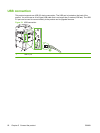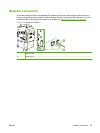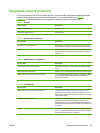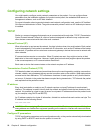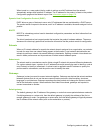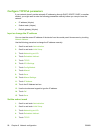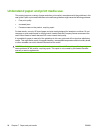
Supported network protocols
The product supports the TCP/IP network protocol, the most widely used and accepted networking
protocol. Many networking services utilize this protocol. For more information, see
TCP/IP
on page 88. The following table lists the supported networking services and protocols.
Table 6-1 Printing
Service name Description
port9100 (Direct Mode) Printing service
Line printer daemon (LPD) Printing service
Table 6-2 Network device discovery
Service name Description
SLP (Service Location Protocol) Device-discovery protocol, used to help find and configure
network devices. Used primarily by Microsoft-based programs.
Bonjour Device-discovery protocol, used to help find and configure
network devices. Used primarily by Apple Macintosh-based
programs.
Table 6-3 Messaging and management
Service name Description
HTTP (Hyper Text Transfer Protocol) Allows Web browsers to communicate with embedded Web
server.
EWS (embedded Web server) Allows a user to manage the product through a Web browser.
SNMP (Simple Network Management Protocol) Used by network applications for product management. SNMP
v1 and standard MIB-II (Management Information Base)
objects are supported.
Table 6-4 IP addressing
Service name Description
DHCP (Dynamic Host Configuration Protocol) For automatic IP address assignment. The DHCP server
provides the product with an IP address. Generally, no user
intervention is required for the product to obtain an IP address
from a DHCP server.
BOOTP (Bootstrap Protocol) For automatic IP address assignment. The BOOTP server
provides the product with an IP address. Requires the
administrator to input a product's MAC hardware address on
the BOOTP server for the product to obtain an IP address from
that server.
Auto IP For automatic IP address assignment. If neither a DHCP
server nor a BOOTP server is present, the product uses this
service to generate a unique IP address.
ENWW Supported network protocols 87






